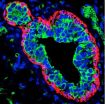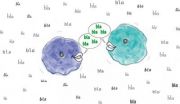(Press-News.org) New York, NY and Uppsala, Sweden, September 24, 2012 – Death plays a big role in keeping things alive. Consider the tightly orchestrated suicide of cells--a phenomenon essential to everything from shaping an embryo to keeping it free of cancer later in life. When cells refuse to die, and instead multiply uncontrollably, they become what we call tumors. An intricate circuitry of biochemical reactions inside cells coordinates their self-sacrifice. Tracing that circuitry is, naturally, an important part of cancer research.
In a major contribution to that effort Dr. Ingvar Ferby, a Ludwig researcher based at Uppsala University in Sweden, led a team of researchers who have determined the outsize role a small protein named Mig6 plays in such processes. Their findings, reported online in the September 11 issue of Developmental Cell, unveil a conceptually novel mechanism for the biological regulation of cell suicide.
The studies focus on epithelial tissue in the mammary glands of mice. Though diverse in function, such epithelial linings--found on the surfaces of virtually every organ and gland in the body--generally consist of a stack of functionally distinct cells layered over a membrane that acts like a floor. The outermost cells of epithelia constantly die, slough off and are replaced. This tightly regulated process is known as epithelial homeostasis; where it breaks down, tumors often ensue.
To figure out what exactly Mig6 does, Ferby and his colleagues studied what happens in the mammary glands of mice engineered to lack the gene for that protein. His laboratory had previously shown that such mice tend to spontaneously develop tumors--suggesting that Mig6 somehow suppresses cancer. In the current study, he and his team noticed that tiny ducts in the mammary glands of these mice were clogged with aberrantly proliferating epithelial cells.
The question was why. To find out, Ferby's team took epithelial cells from mutant mice and their normal littermates and used them to conduct an elegant series of experiments. They discovered that Mig6 is the chief instigator of suicide in these cells.
Mig6 was already known to dampen the signal of a secreted protein named epidermal growth factor (EGF) by binding to its receptor, and EGF plays an important role in maintaining epithelial homeostasis. But Ferby and his colleagues discovered that Mig6 really kicks into gear only after EGF is taken away. It drops off the EGF receptor and promptly latches on to an intracellular protein named cAbl. This activates cAbl, initiating a signaling cascade that reaches into the nucleus and turns on a key enzyme involved in cell suicide.
They next asked what keeps Mig6 from triggering cell death in the presence of EGF?
The answer, it seems, is yet another protein, Src, which is known to be activated by the EGF receptor. Ferby and his colleagues found that Src chemically modifies cAbl in a manner that prohibits its activation by Mig6. Conversely, when EGF is removed and its receptor becomes dormant, Src gets shut down--allowing Mig6 and cAbl to work together to induce cell suicide.
"In other words," explains Sarah Hopkins, a post-doctoral researcher at UCL (University College London) and the lead author of the study, "Mig6 is an intracellular sensor that detects the absence of a proliferative signal, such as EGF, and, in response, induces normal cell death."
Mig6 keeps the growth of epithelial cells dependent on EGF. This is notable because escape from such dependence is an early step in the generation of some tumors. Mig6 is known to be silenced in many human epithelial cancers, including those of the lung, pancreas, breast and skin.
"The findings from this study may have an impact on how we evaluate drugs that inhibit cAbl," says Ferby. "These therapies are designed to target a mutated version of cAbl that promotes cancer. But by disabling healthy cAbl, they may well interfere with a protein essential to Mig6's work inside the cell."
And that work, as these findings suggest, is clearly very important.
INFORMATION:
Publication: 'Mig6 is a sensor of EGR receptor inactivation that directly activates c-Abl to induce apoptosis during epithelial homeostasis,' Sarah Hopkins, Emma Linderoth, Oliver Hantschel, Paula Surarez-Henriques, Giulia Pilia, Howard Kendrick, Matthew J. Smalley, Giulio Superti-Furga, Ingvar Ferby, Developmental Cell, online publication 11 September 2012.
About The Ludwig Institute for Cancer Research
LICR is an international non-profit organization committed to improving the understanding and control of cancer through integrated laboratory and clinical discovery. Leveraging its worldwide network of investigators and the ability to sponsor and conduct its own clinical trials, the Institute is actively engaged in translating its discoveries into applications for patient benefit. Since its establishment in 1971, the Institute has expended more than $1.5 billion on cancer research.
For further information please contact Rachel Steinhardt, rsteinhardt@licr.org or +1-212-450-1582.
Study uncovers mechanism by which tumor suppressor MIG6 triggers cell suicide
2012-09-24
ELSE PRESS RELEASES FROM THIS DATE:
New study shows PTSD symptoms reduced in combat-exposed military via integrative medicine
2012-09-24
SAN DIEGO (Sept. 24, 2012) – Healing touch combined with guided imagery (HT+GI) provides significant clinical reductions in post-traumatic stress disorder (PTSD) symptoms for combat-exposed active duty military, according to a study released in the September issue of Military Medicine.
The report finds that patients receiving these complementary medicine interventions showed significant improvement in quality of life, as well as reduced depression and cynicism, compared to soldiers receiving treatment as usual alone.
The study, led by the Scripps Center for Integrative ...
Pacific Islanders have high obesity, smoking rates
2012-09-24
ANN ARBOR, Mich.—In the first study to detail the health of Pacific Islanders living in the United States, University of Michigan researchers have found alarmingly high rates of obesity and smoking.
The preliminary findings are being presented today (Sept. 24) at a conference in Los Angeles on health disparities among Native Hawaiians and Pacific Islanders.
"Native Hawaiians and Pacific Islanders are the second fastest growing minority population in the U.S.," said Sela Panapasa, a researcher at the U-M Institute for Social Research and principal investigator of the ...
Vitamin D deficiency increases risk of heart disease
2012-09-24
New research from the University of Copenhagen and Copenhagen University Hospital shows that low levels of vitamin D are associated with a markedly higher risk of heart attack and early death. The study involved more than 10,000 Danes and has been published in the well-reputed American journal Arteriosclerosis, Thrombosis and Vascular Biology.
Vitamin D deficiency has traditionally been linked with poor bone health. However, the results from several population studies indicate that a low level of this important vitamin may also be linked to a higher risk of ischemic heart ...
Climate is changing the Great Barrier Reef
2012-09-24
Satellite measurement of sea surface temperatures has yielded clear evidence of major changes taking place in the waters of Australia's Great Barrier Reef over the past 25 years, marine scientists have found.
The changes have big implications for the future management of the GBR and its marine protected areas say Dr Natalie Ban and Professor Bob Pressey of the ARC Centre of Excellence for Coral Reef Studies and James Cook University, who led the study with Dr Scarla Weeks from the University of Queensland.
"When we looked back at satellite data collected since 1985, ...
World Heart Federation says heart health starts earlier than you think
2012-09-24
A new multi-national survey reveals the extent of misconceptions about when is the right time to start taking action to prevent cardiovascular disease (CVD). In a four-country survey sample of 4,000 adults, 49 per cent answered age 30 years or older when asked at what age they believe people should start to take action about their heart health to prevent conditions such as heart disease and stroke. The fact is that CVD can affect people of all ages and population groups, and the risk begins early in life through unhealthy diets, lack of physical activity and exposure to ...
Cellular eavesdropping made easy
2012-09-24
It is much harder to keep up with a conversation in a crowded bar than in a quiet little café, but scientists wishing to eavesdrop on cells can now do so over the laboratory equivalent of a noisy room. A new method devised by scientists at the European Molecular Biology Laboratory (EMBL) in collaboration with the German Cancer Research Centre (DKFZ), both in Heidelberg, Germany, provides a new approach for studying the proteins cells release to communicate with each other, react to changes, or even to help them move. Published online today in Nature Biotechnology, the work ...
New IVF breakthrough
2012-09-24
Researchers at the University of Gothenburg have discovered that a chemical can trigger the maturation of small eggs to healthy, mature eggs, a process that could give more women the chance of successful IVF treatment in the future. The results have been published in the revered journal PloS ONE.
Women and girls treated for cancer with radiotherapy and chemotherapy are often unable to have children as their eggs die as a result of the treatment.
Although it is now possible to freeze eggs and even embryos, this is not an option for girls who have yet to reach puberty. ...
Immune system molecule affects our weight
2012-09-24
Researchers at the Sahlgrenska Academy, University of Gothenburg, Sweden, have identified a molecule in the immune system that could affect hunger and satiety. The researchers hope that new treatments for obesity will benefit from this finding.
Interleukin-6 is a chemical messenger in our immune system that plays an important role in fighting off infection. However, recent research has, surprisingly, shown that it can also trigger weight loss. Researchers at Sahlgrenska Academy, University of Gothenburg, have been investigating and managed to identify the specific types ...
New back pain gene identified in largest genetic study of its kind
2012-09-24
Researchers at King's College London have for the first time identified a gene linked to age-related degeneration of the intervertebral discs in the spine, a common cause of lower back pain.
Costing the UK an estimated £7billion a year due to sickness leave and treatment costs, the causes of back pain are not yet fully understood. Until now, the genetic cause of lower back pain associated with lumbar disc degeneration (LDD) was unknown, but the largest study to date, published this week in the journal Annals of Rheumatic Diseases, has revealed an association with the ...
Red king or red queen
2012-09-24
This press release is available in German.
The relationship between species determines how rapidly they evolve. Parasites and their hosts coevolve more rapidly, and partners in a mutualistic relationship can evolve more slowly. But this view is obviously too simplistic. The rate of evolution in a mutualistic relationship does not depend only on the type of interactions, but also on the number of individuals involved, according to a model developed by researchers of the Max Planck Institute for Evolutionary Biology in Plön, Germany. Therefore, while partners can benefit ...


